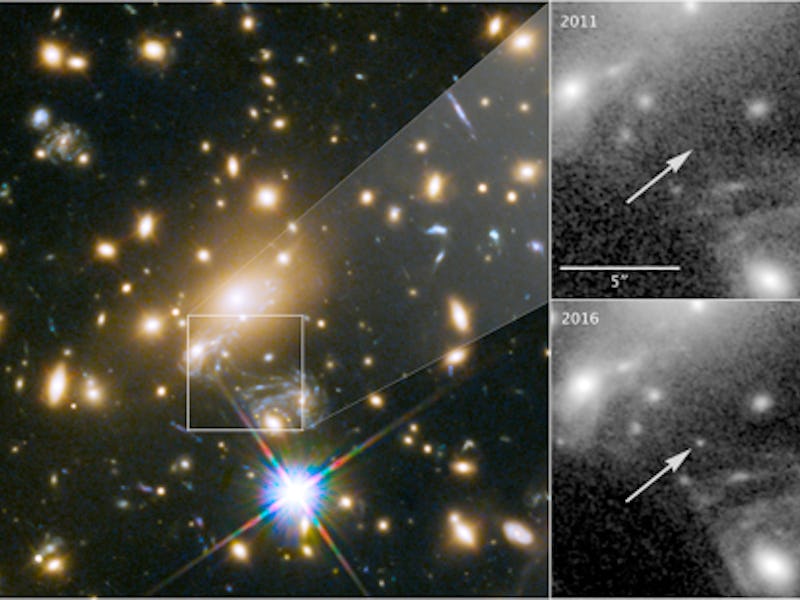Hubble Spots the Farthest Star in the Universe by Coincidence
The discovery has big implications for the study of dark matter.

Sometimes the best scientific discoveries happen by accident, and even though there aren’t any test tubes to spill in an astronomical observatory, the field of space science is no exception. Most recently, an incident of cosmic happenstance has led scientists to discover a star that’s farther away from Earth than any star that’s ever been observed by humans — 9 billion light-years away. The best part? They weren’t even looking for it. Here’s what happened.
While observing a galaxy cluster designated MACS J1149+2223 with the Hubble Telescope, a team led by Patrick Kelly, Ph.D. noticed a distant star. Through an effect called gravitational lensing, a result of the massive cluster’s gravity distorting space-time, objects beyond it appear magnified. This allowed astronomers to observe the otherwise very dim star they’ve named “Icarus,” a blue supergiant star that’s bigger and hotter than our sun. Kelly, an assistant professor of astronomy and physics at the University of Minnesota, and his colleagues published their findings in a paper Monday in the journal Nature Astronomy, in which they give the star the much less exciting name: MACS J1149+2223 Lensed Star 1.
Galaxy cluster MACS J1149+2223 (left) distorted space-time, allowing astronomers to see Icarus 4 billion light-years beyond it. In 2011, (top right) Icarus wasn't visible, but in 2016 (bottom right) it was.
“This is the first time we’re seeing a magnified, individual star,” Kelly said in a statement. “You can see individual galaxies out there, but this star is at least 100 times farther away than the next individual star we can study, except for supernova explosions.” If not for the gravitational lensing, which the study’s authors write magnified Icarus more than 2,000 times, the star would have remained unnoticed.
Besides the fact that this star is much farther away than anything astronomers have ever directly observed, the discovery also has big implications for the study of dark matter, the mysterious substance that constitutes most of the mass in the universe but which scientists have never directly observed. One of the major hypotheses explaining the source of dark matter is that it came from primordial black holes in the early universe. But the study’s authors’ observations provide evidence that counters this hypothesis. Observing the galaxy cluster and the background star over a number of years, researchers did not see the kind of light fluctuations that would come from these primordial black holes.
Astronomers hope to get more insight into the nature of dark matter when the James Webb Space Telescope launches in 2020. Until then, indirect observations like this one are the best we can hope for.